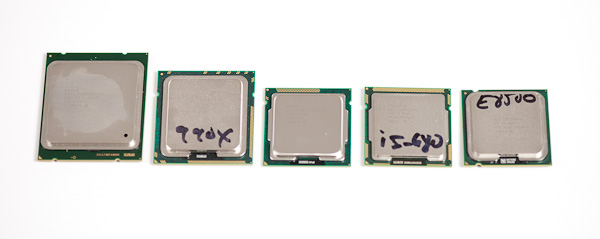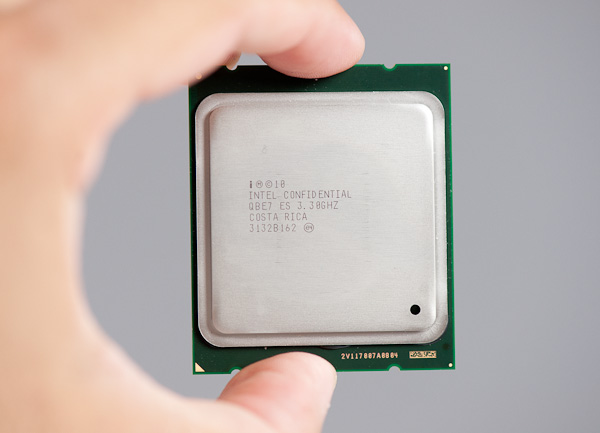Intel Core i7 3960X (Sandy Bridge E) Review: Keeping the High End Alive
by Anand Lal Shimpi on November 14, 2011 3:01 AM EST- Posted in
- CPUs
- Intel
- Core i7
- Sandy Bridge
- Sandy Bridge E
Final Words
There are two aspects of today's launch that bother me: the lack of Quick Sync and the chipset. The former is easy to understand. Sandy Bridge E is supposed to be a no-compromise, ultra high-end desktop solution. The lack of an on-die GPU with Quick Sync support means you have to inherently compromise in adopting the platform. I'm not sure what sort of a solution Intel could've come to (I wouldn't want to give up a pair of cores for a GPU+QuickSync) but I don't like performance/functionality tradeoffs with this class of product. Secondly, while I'm not a SAS user, I would've at least appreciated some more 6Gbps SATA ports on the chipset. Native USB 3.0 support would've been nice as well. Instead what we got was effectively a 6-series chipset with a new name. As Intel's flagship chipset, the X79 falls short.

From left to right: Intel Core i7 (SNB-E), Core i7 (Gulftown), Core i5 (SNB), Core i5 (Clarkdale), Core 2 Duo
LGA-2011, 1366, 1155, 1156, 775
The vast majority of desktop users, even enthusiast-class users, will likely have no need for Sandy Bridge E. The Core i7 3960X may be the world's fastest desktop CPU, but it really requires a heavily threaded workload to prove it. What the 3960X doesn't do is make your gaming experience any better or speed up the majority of desktop applications. The 3960X won't be any slower than the fastest Sandy Bridge CPUs, but it won't be tremendously faster either. The desktop market is clearly well served by Intel's LGA-1155 platform (and its lineage); LGA-2011 is simply a platform for users who need a true powerhouse.
There are no surprises there, we came to the same conclusion when we reviewed Intel's first 6-core CPU last year. If you do happen to have a heavily threaded workload that needs the absolute best performance, the Core i7 3960X can deliver. In our most thread heavy tests the 3960X had no problems outpacing the Core i7 2600K by over 50%. If your livelihood depends on it, the 3960X is worth its entry fee. I suspect for those same workloads, the 3930K will be a good balance of price/performance despite having a smaller L3 cache. I'm not terribly interested in next year's Core i7 3820. Its point is obviously for those users who need the memory bandwidth or PCIe lanes of SNB-E, but don't need more than four cores. I would've liked to have seen a value 6-core offering instead, but I guess with a 435mm2 die size it's a tough sell for Intel management.
Of course compute isn't the only advantage of the Sandy Bridge E platform. With eight DIMM slots on most high end LGA-2011 motherboards you'll be able to throw tons of memory at your system if you need it without having to shop for workstation motherboards with fewer frills.
As for the future of the platform, Intel has already begun talking about Ivy Bridge E. If it follows the pattern set for Ivy Bridge on LGA-1155, IVB-E should be a drop in replacement for LGA-2011 motherboards. The biggest issue there is timing. Ivy will arrive for the mainstream LGA-1155 platforms around the middle of 2012. At earliest, I don't know that we'd see it for LGA-2011 until the end of next year, or perhaps even early 2013 given the late launch of SNB-E. This seems to be the long-term downside to these ultra high-end desktop platforms these days: you end up on a delayed release cadence for each tick/tock on the roadmap. If you've always got to have the latest and greatest, this may prove to be frustrating. Based on what we know of Ivy Bridge however, I suspect that if you're using all six of these cores in SNB-E that you'll wish you had IVB-E sooner, but won't be tempted away from the platform by a quad-core Ivy Bridge on LGA-1155.
I do worry about the long term viability of the ultra high-end desktop platform. As we showed here, some of the gains in threaded apps exceed 50% over a standard Sandy Bridge. That's tangible performance to those who can use it. With the growth in cloud computing it's clear there's demand for these types of chips in servers. I just hope Intel continues to offer a version for desktop users as well.











163 Comments
View All Comments
SonicIce - Monday, November 14, 2011 - link
cool good review.wharris1 - Monday, November 14, 2011 - link
It would be interested to test the OC'd SBE vs an OC'd SB; I suspect that the 2x advantage of the SBE would fall back in line to around the ~30-40% speed advantage seen in non-OC'd testing (in heavily threaded workloads). I have the feeling that between being defective xeon CPU parts and lacking more SATA 6Gbs as well as USB 3.0 functionality on the motherboard side, this release is a bit hamstrung. I be that with the release of Ivy Bridge E parts/motherboards, this combo will be more impressive. Part of the problem is that the regular SB parts are so compelling from a price/performance perspective. As always, nice review.Johnmcl7 - Monday, November 14, 2011 - link
I thought that odd as well as it almost implies the regular Sandybridge processors are poor overclockers when there are results for the new processor overclocked and Bulldozer overclocked. I guess though it's more it would be interesting to see rather than actually change anything, I currently have an i7 960 and was hoping for an affordable six core processor but it's looking like I'll wait until Ivybridge nowTunnah - Monday, November 14, 2011 - link
although i can understand the expectation of all 6 ports being sata 3, maybe the reasoning is implementing it would probably be pointless for 99.9% of users - i can't even begin to imagine any none-enterprise usage for 6 SSDs running at max speed!Exodite - Monday, November 14, 2011 - link
While I personally don't disagree with most people not needing more than two SATA 6Gbps ports you have to keep in mind that 99.9% of all users have no need for the SB-E /platform/ in its entirety.Since it's squarely aimed at workstation power users and extreme-end enthusiasts, those last 0.1% of users if you will, offering more SATA 6.0Gbps ports makes sense.
Zoomer - Monday, November 14, 2011 - link
I can't imagine the area difference being an issue. Like, are sata3 controllers really that different once it was already done and validated? Having two types of sata controllers on chip seems redundant to me. It's like PCIe 1.0 vs 2.0; once you have the 2.0 implementationd one, there's no reason to have 1.0 only lanes since it is backwards compatible.Jaybus - Tuesday, November 15, 2011 - link
The reason for keeping SATA 3Gbps and PCIe 1.0 is not a die area issue or lack of reasoning. SATA 6Gbps takes considerably more power than 3Gbps, and PCIe 2.0 likewise consumes more power than 1.0. It's simply the physical reality of higher transfer rates. SB-E is already at 130 W, so there simply isn't room in the power envelope to make every interface the highest speed available.MossySF - Tuesday, November 15, 2011 - link
We ran into this problem. Our data processing database has 1 slow SSD for a boot drive and 5 x Sandforce SATA3 SSDS in a RAID0 array ... and we can't do even half the speed the SSDs can run at.You might say why would a non-enterprise user being using this many SSDs? Uh, why would a non-enterprise user be running this obscenely fast computer? You need this much speed to play Facebook Farmville?
ltcommanderdata - Monday, November 14, 2011 - link
Given Ivy Bridge is coming in a few months, perhaps you could comment whether SB-E is worth it even for power users at this time? Has there been indications that high-end Ivy Bridge will likewise launch much later than mainstream parts? Is LGA 2011 going to be around a while or will it need to be replaced if high-end Ivy Bridge decides to integrate an IGP for QuickSync support and as an OpenCL co-processor?DanNeely - Monday, November 14, 2011 - link
I don't think Intel's spoken publicly about IB-E yet.That said, Intel hasn't done socket changes for any of the other recent die shrinks so I doubt we'll see one for ivy. Incremental gains in clock speed, and possibly pushing more cores down to lower price points ($300 6 core, or $1000 8 core) are the most likely results.
OTOH if its launch is as delayed as SB-E's was Haswell will be right around the corner and there will again be the risk of the new quad core wiping the floor with the old hex for most workloads.